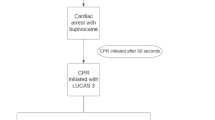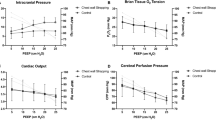Summary
During an experimentally induced aggressive epidural bleed the effect on outcome of haematoma volume, cerebral perfusion pressures, intracranial pressure gradients and ventilation were examined in a swine model. Two groups of experiments were performed using either spontaneous ventilation (group 1, n=6) or mechanical ventilation for 1 hour (group 2, n=7). The preparations were otherwise identical. An animal was considered to have succumbed when the EEG became irreversibly isoelectric within a total follow-up time of 80 minutes.
Mechanical ventilation had a marked effect on survival. All spontaneously ventilated animals succumbed, 4 of them in less than 60 minutes, the remaining 2 between 60 and 80 minutes after the start of bleeding. All mechanically ventilated animals survived for the 60 minutes while the ventilator was connected. Following disconnection 2 animals started to breathe spontaneously and survived the final 20 minutes of the 80 minutes of the follow-up time. The remaining 5 succumbed following apnoea.
The size of haematoma did not differ significantly between the groups. Two additional factors, hypoventilation and a secondary rise in supratentorial pressure, contributed to a lethal outcome.
Hypoventilation was an inevitable precursor of the isoelectric EEG. There was a close correlation between the development of hypoventilation and intracranial herniation.
A secondary rise in supratentorial pressure, unrelated to ventilation, was seen after cessation of bleeding in 8/13 cases. It was associated with a falling supratentorial perfusion pressure and EEG attenuation, suggesting a secondary intracranial expansion, possibly due to oedema, hydrocephalus or both.
It is concluded that mechanical ventilation in the acute stage of epidural bleeding may be of clinical value. Due to the particular form of the time/pressure course, in epidural bleeding, this treatment may have considerable therapeutic value.
Similar content being viewed by others
References
Aoki N (1988) Rapid resolution of acute epidural hematoma. J Neurosurg 68: 149–151
Bederson JB, Bartokowski HM, Moon K, Halks-Miller M, Nishimura MC, Brant-Zadawski M, Pitts LH (1986) Nuclear magnetic resonance imaging and spectroscopy in experimental brain edema in a rat model. J Neursourg 64: 795–802
Bricolo AB, Paust LM (1984) Extradural hematoma: towards zero mortality — a prospective study. Neurosurg 14: 8–12
Choux M, Gridoloi F, Peragut J-C (1975) Extradural hematomas in children. Child's Brain 1: 337–347
Cordobes F, Lobato RD, Rivas JJ, Munoz MJ, Chillon D, Portillo JM, Lamas E (1981) Observations on 82 patients with extradural hematoma. J Neurosurg 54: 179–186
Ford LE, McClaurin RL (1963) Mechanisms of epidural hematomas. J Neurosurg 20: 760–769
Gallagher JP, Browder EJ (1968) Extradural hematoma — experience with 167 patients. J Neurosurg 29: 1–12
Ganz JC, Thuomas K-Å, Vlajkovic S, Nilsson P, Bergström K, Pontén U, Zwetnow NN. Changes in intracranial morphology, regional cerebral water content and vital physiological variables during epidural bleeding. In preparation.
Ganz JC, Zwetnow NN (1988) Analysis of the dynamics of experimental epidural bleeding in swine. Acta Neurochir (Wien) 95: 72–81
Grant WT (1944) Chronic epidural hematoma. Bull Los Angeles Neurol Sci 9: 156–169
Greenburg J, Cohen WA, Cooper PR (1985) The hyperacute extraaxial intracranial hematoma: computed tomographic findings and clinical significance. Neurosurg 17: 48–55
Habash AH, Sortland O, Zwetnow NN (1982) Epidural haematoma: pathophysiological significance of extravasation and arterio-venous shunting: an analysis of 35 patients. Acta Neurochir (Wien) 60: 7–27
Habash AH, Zwetnow NN, Ericson H, Löfgren JU (1983) Arteriovenous epidural shunting in epidural bleedings — radiological and physiological characteristics: an experimental study in dogs. Acta Neurochir (Wien) 63: 291–313
Hirsh LF (1980) Chronic epidural hematomas. Neurosurg 6: 508–512
Hooper RS (1954) Extradural haemorrhages of the posterior fossa. Br J Surg 42: 19–26
Iwakuma T, Brunngraber CV (1973) Chronic extradural hematomas — a study of 21 cases. J Neurosurg 38: 488–493
Jacobson WHA (1885/86) On middle meningeal haemorrhage. Guy's Hosp Rep 43: 147–308
Jamieson KG, Yelland JDN (1968) Extradural hematoma — report of 167 cases. J Neurosurg 29: 13–23
Jonker C, Oosterhuis HJ (1975) Epidural haematoma — a retrospective study of 100 patients. Clin Neurol Neurosurg 78: 233–245
Kalyanaraman S, Ramamurthi B (1968) Extradural haemorrhage — a review of 17 cases. J Indian Med Ass 50: 199–201
Kvarnes TL, Trumpy JH (1978) Extradural haematoma — report of 132 cases. Acta Neurochir (Wien) 41: 223–231
Lake PA, Pitts FW (1971) Recent experiences with epidural hematomas. J Trauma 11: 397–411
Lobato RD, Rivas JJ, Cordobes F, Alted E, Perez C, Sarabia R, Cabrera A, Diez I, Gomez P, Lamas E (1988) Acute epidural hematoma: an analysis of factors influencing the outcome of patients undergoing surgery in coma. J Neurosurg 68: 48–57
Lumb WV, Jones EW (1984) Veterinary anesthesia. Lea & Febiger, Philadelphia, pp 458–460
Löfgren J, Zwetnow NN (1972) Kinetics of arterial and venous hemorrhage in the skull cavity. In: Brock M, Dietz H (eds) Intracranial pressure. Springer, Berlin Heidelberg New York, pp 155–159
McKissock W, Taylor JC, Bloom WH, Till K (1960) Extradural haematoma — observations on 125 cases. Lancet 2: 168–172
McClaurin RL, Ford LE (1964) Extradural hematoma — statistical survey of forty-seven cases. J Neurosurg 21: 364–371
Munro D, Maltby GL (1941) Extradural hemorrhage — a study of forty-four cases. Ann Surg 113: 192–203
Murzin VE, Goryunov VN (1979) Study of the strength of fixation of dura mater to the cranial bones. Zhur Voprosy Neirokhir 4: 43–47
Pozzati E, Frank F, Frank G, Gaist G (1980) Subacute and chronic extradural hematomas: a study of 30 cases. J Trauma 20: 795–799
Pozzati E, Tognetti F (1984) Spontaneous healing of extradural hematomas: report of four cases. Neurosurg 14: 724–727
Pozzati E, Tognetti F (1986) Spontaneous healing of acute extradural hematomas: study of twenty-two cases. Neurosurg 18: 696–700
Schecter MM, Zingesser LH, Rayport M (1966) Torn meningeal vessels: An evaluation of the clinical spectrum through the use of angiography. Radiology 86: 686–695
Schrader H, Löfgren J, Zwetnow NN (1985) Influence of blood presure on tolerance to an intracranial expanding mass. Acta Neurol Scand 71: 114–126
Schrader H, Zwetnow NN, Mørkrid L (1985) Regional cerebal blood flow and CSF pressures during cushing response induced by a supratentorial expanding mass. Acta Neurol Scand 71: 453–463
Zuccarello M, Fiore DL, Pardatscher K, Trincia G, Andrioli GC (1983) Chronic Epidural Haematomas. Acta Neurochir (Wien) 67: 57–66
Zwetnow NN, Habash AH, Löfgren J, Håkonsson S (1983) Comparative analysis of experimental epidural and subarachnoid bleedings in dogs. Acta Neurochir (Wien) 67: 67–70
Zwetnow NN, Schrader H, Löfgren J (1986) Effects of continuously expanding intracranial lesions on viral physiological parameters: an experimental animal study. Acta Neurochir (Wien) 47–56
Author information
Authors and Affiliations
Rights and permissions
About this article
Cite this article
Ganz, J.C., Zwetnow, N.N. A quantitative study of some factors affecting the outcome of experimental epidural bleeding in swine. Acta neurochir 102, 164–172 (1990). https://doi.org/10.1007/BF01405433
Issue Date:
DOI: https://doi.org/10.1007/BF01405433




